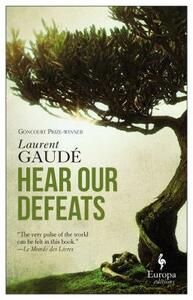You need to sign in or sign up before continuing.
Take a photo of a barcode or cover
dark
reflective
sad
fast-paced
L’idée derrière le livre est assez simple et rapidement comprise donc on sait exactement où l’auteur veut aller. Cependant, je l’ai quand même lu d’une traite avec plaisir par envie de savoir où se dirigent les personnages.
Disparate but well-entwined stories of battles lost and won. Even in victory there is defeat.
I started this for my book group, but the meeting was cancelled because of Covid lockdown, so I was happy to toss it aside. It's not a novel but a philosophical disquisition, and not a terribly original one at that. I'm not giving it a rating as I haven't finished it.
Un récit époustouflant qui présente la guerre sous ses multiples formes comme des convulsions de l'Histoire (considérée comme personnage à part entière) qui poussent ses participants à déclarer "plus jamais cela" (p231), mais tout en montrant sa répétition cyclique...
Mélancolique et désabusé, ce portrait lyrique de la folie des hommes subjugue par une écriture à couper le souffle, un désespoir et une rage de vaincre étouffante et des personnages qui continuent de hanter le lecteur bien après avoir refermé l'ouvrage. Comme toujours avec Laurent Gaudé, c'est une pépite à découvrir absolument.
Mon avis complet à retrouver sur le blog : https://auxmotsinsatiables.wordpress.com/2020/11/18/book-review-ecoutez-nos-defaites-de-laurent-gaude/
Mon avis complet à retrouver sur le blog : https://auxmotsinsatiables.wordpress.com/2020/11/18/book-review-ecoutez-nos-defaites-de-laurent-gaude/
Disparate but well-entwined stories of battles lost and won. Even in victory there is defeat.
Hear Our Defeats is a unique combination of narratives, at once historical and contemporary. As we follow the separate paths of two lovers, Miriam and Assem, after they share a night together, historical narratives of war are interspersed throughout. While the historical moments do not mirror the paths of Miriam and Assem, they inform the reading of each character's sections. I'm not quite sure I've completely sorted out the significance of the historical sections to the contemporary narrative--it's a very intellectual play that might not be for every reader. The basic lesson seems to be the title itself-- acknowledging and coming to terms with the cruelty of life and humanity that kind of grinds down on you throughout your life. (I think? Still unsure tbh)
In the beginning, it was hard for me to sort out all of the different narratives, since they flow seamlessly from one to the other. I think it might have been helpful to have more division between the different narratives, or at least offer more clues as to when/where the story is switching to. I also think there could have been fewer historical narratives--I think there are maybe 4 or 5? It gets a little confusing and tiresome after awhile.
I also think that the historical narratives take away from the contemporary storyline. I think Miriam and Assem were really unique and interesting characters, and I would have liked to spend more time with them, rather than the couple of paragraphs we get before switching narratives. There were so many interesting plot points in Miriam and Assem's story that I wish I could have delved deeper into... but alas.
Overall, I thought this was a really interesting blend of narratives that I have not read before--a combo history, spy and art history novel. While the pacing left something to be desired, I still think this is an intriguing story, and if the summary intrigues you, I'd give it a go! It's quite a short read too, which helps. 3.5 stars
In the beginning, it was hard for me to sort out all of the different narratives, since they flow seamlessly from one to the other. I think it might have been helpful to have more division between the different narratives, or at least offer more clues as to when/where the story is switching to. I also think there could have been fewer historical narratives--I think there are maybe 4 or 5? It gets a little confusing and tiresome after awhile.
I also think that the historical narratives take away from the contemporary storyline. I think Miriam and Assem were really unique and interesting characters, and I would have liked to spend more time with them, rather than the couple of paragraphs we get before switching narratives. There were so many interesting plot points in Miriam and Assem's story that I wish I could have delved deeper into... but alas.
Overall, I thought this was a really interesting blend of narratives that I have not read before--a combo history, spy and art history novel. While the pacing left something to be desired, I still think this is an intriguing story, and if the summary intrigues you, I'd give it a go! It's quite a short read too, which helps. 3.5 stars




